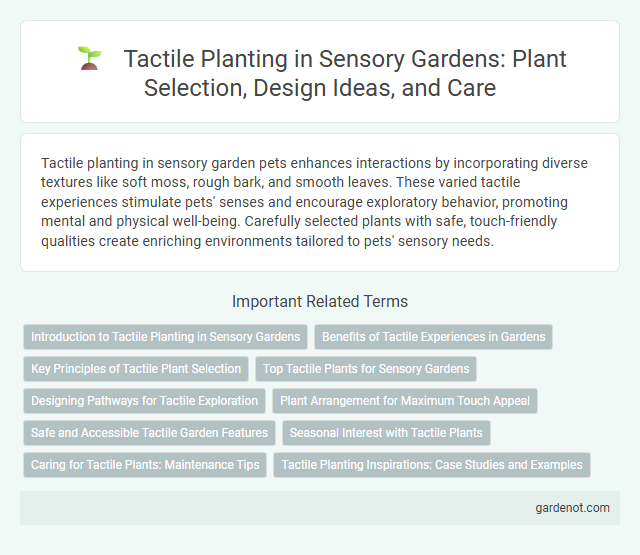Tactile planting in sensory garden pets enhances interactions by incorporating diverse textures like soft moss, rough bark, and smooth leaves. These varied tactile experiences stimulate pets' senses and encourage exploratory behavior, promoting mental and physical well-being. Carefully selected plants with safe, touch-friendly qualities create enriching environments tailored to pets' sensory needs.
Introduction to Tactile Planting in Sensory Gardens
Tactile planting in sensory gardens enhances tactile stimulation by incorporating a variety of plants with diverse textures, such as soft lamb's ear, rough sagebrush, and spiky ornamental grasses. This approach fosters interactive experiences that engage visitors' sense of touch while promoting accessibility for individuals with visual impairments. Strategically selecting plants with contrasting textures supports therapeutic objectives and encourages mindful exploration of the environment.
Benefits of Tactile Experiences in Gardens
Tactile planting in sensory gardens enhances cognitive development and sensory integration by engaging touch receptors with diverse textures such as soft lamb's ear or rough tree bark. These tactile experiences promote emotional well-being, reduce stress, and encourage mindfulness, benefiting individuals with sensory processing disorders and dementia. Gardens incorporating textured foliage and interactive elements improve motor skills and foster deeper connections with nature for all visitors.
Key Principles of Tactile Plant Selection
Tactile planting in sensory gardens prioritizes plants with varied textures, such as velvety lamb's ear, rough ornamental grasses, and smooth succulents, to engage touch senses effectively. Key principles include selecting species that are safe, non-toxic, and resilient to frequent handling while offering diverse tactile experiences like softness, rigidity, and prickliness. Incorporating plants with contrasting tactile qualities supports sensory development and enhances the therapeutic value of the garden.
Top Tactile Plants for Sensory Gardens
Top tactile plants for sensory gardens include lamb's ear (Stachys byzantina), known for its soft, velvety leaves that invite touch, and ornamental grasses like fountain grass (Pennisetum alopecuroides) offering feathery textures. Other excellent tactile selections are the fuzzy leaves of the silver sage (Salvia argentea) and the rough, textured bark of cedar trees, which provide varied sensory experiences. Incorporating a mix of these plants enhances tactile engagement, making sensory gardens rich in touch-based stimulation.
Designing Pathways for Tactile Exploration
Designing pathways for tactile exploration in sensory gardens prioritizes varying textures, materials, and heights to engage visitors' sense of touch effectively. Incorporating elements like smooth pebbles, rough bark, soft moss, and raised planting beds encourages interactive learning and sensory stimulation. Strategic layout of these tactile features ensures safe, inclusive access and enhances the overall sensory experience.
Plant Arrangement for Maximum Touch Appeal
Tactile planting in sensory gardens emphasizes strategic plant arrangement to maximize touch appeal by incorporating diverse textures such as soft lamb's ear, rough rosemary, and smooth ornamental grasses. Grouping plants with contrasting tactile qualities enhances sensory exploration and encourages interactive engagement, making the garden accessible and stimulating for all visitors. Careful placement of these textured plants along accessible pathways and raised beds ensures easy reach and prolonged tactile experiences.
Safe and Accessible Tactile Garden Features
Safe and accessible tactile garden features incorporate a variety of textured plants like lamb's ear, ornamental grasses, and succulents, designed to engage touch while minimizing potential irritants. Raised beds and smooth pathways ensure wheelchair-friendly navigation, combined with clear signage that offers braille or audio descriptions for those with visual impairments. Soft, non-toxic plant selections and strategically placed seating create an inclusive environment where visitors of all abilities can explore sensory experiences confidently.
Seasonal Interest with Tactile Plants
Tactile planting in sensory gardens emphasizes seasonal interest by incorporating diverse textures that change throughout the year, such as the soft velvety leaves of lamb's ear in spring and summer and the coarse, spiky seed heads of ornamental grasses in autumn. Plants like lamb's ear (Stachys byzantina), lamb's ear, sedum, and lamb's ear provide hands-on sensory engagement while offering visual and tactile variety across seasons. This approach enhances accessibility and stimulates sensory awareness by inviting touch and interaction with plants that respond to seasonal shifts.
Caring for Tactile Plants: Maintenance Tips
Regular pruning and gentle cleaning are essential for maintaining the health of tactile plants, ensuring their textures remain vibrant and engaging. Using organic mulch helps retain moisture, supporting sensory roots and preventing soil erosion in sensory gardens. Selecting hardy, disease-resistant species minimizes maintenance efforts while providing consistent tactile experiences for visitors.
Tactile Planting Inspirations: Case Studies and Examples
Tactile planting in sensory gardens enhances user engagement by incorporating diverse textures and plant forms that invite touch, such as lamb's ear with its velvety leaves and ornamental grasses with fine blades. Case studies from renowned sensory gardens, including the Healing Garden at Singapore's National University Hospital and the Royal Horticultural Society's Garden at Wisley, demonstrate how tactile plants stimulate sensory development and therapeutic benefits. Examples of successful tactile planting emphasize the strategic layering of rough, smooth, soft, and spiky foliage to create a rich, interactive environment for visitors with sensory processing needs.
Tactile planting Infographic

 gardenot.com
gardenot.com